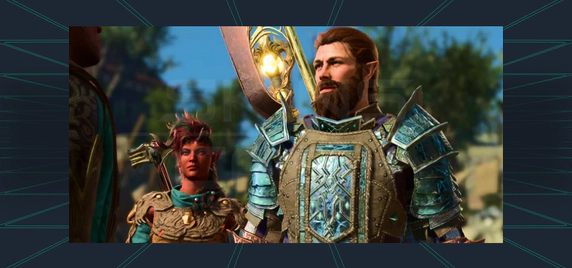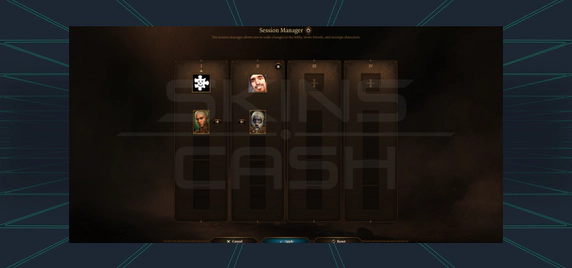How to play Multiplayer in BG3
Table of Contents
Embarking on a cooperative quest through the realms of Baldur’s Gate 3 promises an enthralling experience that transcends the conventional boundaries of single-player adventures. This meticulously crafted guide delves into the intricacies of multiplayer mode, unveiling its mechanics, strategies, and the myriad of possibilities it holds for forging unforgettable tales with friends.
The Multiplayer Mechanics Unraveled
 Baldur’s Gate 3’s multiplayer mode operates in a unique manner, distinct from many contemporary games. Instead of players seamlessly joining and exiting each other’s worlds with their individual characters, the characters in this epic RPG are inextricably tied to campaign save files. These save files serve as the proverbial tabletop where your adventuring party congregates, preserving the intricate details of your characters from your previous escapades.
Baldur’s Gate 3’s multiplayer mode operates in a unique manner, distinct from many contemporary games. Instead of players seamlessly joining and exiting each other’s worlds with their individual characters, the characters in this epic RPG are inextricably tied to campaign save files. These save files serve as the proverbial tabletop where your adventuring party congregates, preserving the intricate details of your characters from your previous escapades.
To embark on a multiplayer campaign, the host player must load the most recent save file, extending an invitation to their comrades to join the metaphorical table. Once assembled, each player assumes control over their respective character, with the ability to assign control of non-player companions (NPCs) to specific individuals within the party.
The Boundless Realm of Cooperative Exploration
Within the confines of Baldur’s Gate 3’s multiplayer mode, players are granted an unprecedented degree of freedom to chart their own courses. While one adventurer engages in a riveting dialogue with a non-player character (NPC), others can observe and suggest dialogue options, albeit without the authority to make final decisions. This dynamic allows for a collaborative storytelling experience, akin to the camaraderie shared around a traditional tabletop gaming session.
Moreover, the game’s sandbox nature empowers co-op players to venture forth independently, pursuing their own objectives or engaging in turn-based battles while their companions explore distant corners of the map. This freedom fosters an unpredictable and organic flow, potentially giving rise to comedic moments and forging bonds that mirror those cultivated during in-person roleplaying sessions.
Initiating and Sustaining a Multiplayer Campaign
 To embark on a fresh cooperative journey through the realms of Baldur’s Gate 3, players must navigate to the “Multiplayer” option from the main menu. Here, they can create a lobby, inviting friends from their Steam contacts or opting for a public session, allowing any adventurer to join the quest.
To embark on a fresh cooperative journey through the realms of Baldur’s Gate 3, players must navigate to the “Multiplayer” option from the main menu. Here, they can create a lobby, inviting friends from their Steam contacts or opting for a public session, allowing any adventurer to join the quest.
For those seeking to resume an existing campaign, the host player must load the most recent save file and extend invitations to their companions through the “Session” menu. This menu also grants the host the ability to assign characters to their respective players, ensuring a seamless continuation of the narrative.
Integrating New Adventurers into an Ongoing Saga
Baldur’s Gate 3 accommodates the seamless integration of new players into an ongoing campaign, granting them the opportunity to create custom characters upon joining. These freshly minted adventurers will be granted levels commensurate with the host’s progress, ensuring a balanced and cohesive experience for all.
It’s important to note that if a player disconnects or is unavailable during a session, their character’s control can be reassigned to another participant through the Session menu, ensuring the narrative’s uninterrupted flow.
The Allure and Considerations of Cooperative Play
While the decision to embark on a solo or cooperative journey through Baldur’s Gate 3 is a matter of personal preference, both approaches hold their unique allures and considerations. Here, we explore the potential pros and cons of multiplayer mode:
Pros of Baldur’s Gate 3 Multiplayer:
- Shared Responsibility: Managing a full party of four Dungeons & Dragons characters can be a daunting task for a single player. Dividing responsibilities among a cooperative group allows for focused character development and strategic decision-making.
- Emergent Storytelling: The sandbox nature of Baldur’s Gate 3 creates opportunities for organic, unscripted moments and genuine bonding experiences akin to those shared during in-person tabletop roleplaying sessions.
- Collaborative Problem-Solving: Navigating the game’s intricate puzzles and challenges becomes a collaborative endeavor, fostering teamwork and creative problem-solving strategies.
Cons of Baldur’s Gate 3 Multiplayer:
- Extended Campaign Duration: Coordinating schedules and ensuring all players are available for prolonged sessions can significantly extend the time required to complete the campaign.
- Potential Distractions: The presence of other players can occasionally disrupt immersion, with their characters inadvertently wandering into dramatic dialogue scenes.
- Divergent Narrative Paths: Differing player decisions may steer the campaign in undesired directions, potentially conflicting with individual preferences for the overarching narrative.
- Restricted Romantic Interactions: While players can pursue romantic relationships with NPCs, they cannot initiate such connections with each other or with played Origin characters.
Preparing for a Multiplayer Adventure
 Before embarking on a cooperative quest through the realms of Baldur’s Gate 3, it’s crucial to consider a few preparatory steps to ensure a seamless and enjoyable experience:
Before embarking on a cooperative quest through the realms of Baldur’s Gate 3, it’s crucial to consider a few preparatory steps to ensure a seamless and enjoyable experience:
- Establish Clear Communication Channels: Determine the preferred method of communication with your party, whether through in-game voice chat, a dedicated voice application, or a combination of both. Clear communication is vital for coordinating strategies and fostering a cohesive gameplay experience.
- Align Expectations and Playstyles: Discuss each player’s preferred playstyle, narrative preferences, and overall goals for the campaign. This open dialogue can help mitigate potential conflicts and ensure a harmonious cooperative experience.
- Designate Roles and Responsibilities: Consider assigning specific roles or responsibilities to each player, such as dedicated healers, ranged combatants, or puzzle-solvers. This division of labor can streamline decision-making and optimize the party’s overall effectiveness.
- Establish Session Schedules: Coordinate schedules and determine a consistent playtime that accommodates all participants. This proactive approach can minimize disruptions and ensure a smooth progression through the campaign.
The Art of Cooperative Storytelling
 One of the most captivating aspects of Baldur’s Gate 3’s multiplayer mode is the opportunity to collectively craft a narrative that transcends the boundaries of a single player’s perspective. By embracing the following principles, you and your party can elevate your cooperative storytelling experience:
One of the most captivating aspects of Baldur’s Gate 3’s multiplayer mode is the opportunity to collectively craft a narrative that transcends the boundaries of a single player’s perspective. By embracing the following principles, you and your party can elevate your cooperative storytelling experience:
- Embrace Divergent Perspectives: Encourage each player to bring their unique perspectives and interpretations to the table. This diversity can enrich the narrative, exposing the party to alternative viewpoints and fostering engaging discussions.
- Foster Collaborative Decision-Making: While individual players may have autonomy over their characters, strive to involve the entire party in significant decisions that shape the overarching narrative. This collaborative approach can foster a sense of shared ownership and investment in the unfolding story.
- Encourage Roleplaying and Improvisation: Embrace the spirit of improvisation by encouraging players to fully immerse themselves in their characters’ personas. This commitment to roleplaying can breathe life into the narrative, creating organic and memorable moments that transcend scripted events.
- Celebrate Emergent Storytelling: Remain open to the unexpected twists and turns that arise from the game’s sandbox nature. Embrace these unscripted moments as opportunities to craft unique and compelling narratives that diverge from predetermined paths.
Navigating Romantic Entanglements in Multiplayer
While players cannot initiate romantic relationships with each other or with played Origin characters, Baldur’s Gate 3 offers the opportunity to pursue amorous connections with NPCs. However, this aspect of the game introduces its own set of considerations in a multiplayer context:
- Assign NPC Companions: In the Session menu, the host player can assign control of NPC companions to specific players. The player assigned to an NPC companion will have the ability to initiate dialogue scenes and potentially pursue romantic interactions with that character.
- Respect Privacy Preferences: Baldur’s Gate 3 allows players to hide private moments, such as romance scenes, from their co-op partners by default. Respect each player’s preferences regarding the visibility of these intimate interactions.
- Coordinate Romantic Pursuits: If multiple players wish to pursue a romantic relationship with the same NPC, open communication and coordination can help prevent potential conflicts or misunderstandings.
- Embrace Narrative Opportunities: While romantic entanglements may introduce complexities in a multiplayer setting, they also present opportunities for compelling storytelling and character development within the context of the shared narrative.
Mastering Multiplayer Combat Strategies
Engaging in combat encounters as a cooperative party introduces unique challenges and opportunities for strategic coordination. To maximize your party’s effectiveness in battle, consider the following tactics:
- Complementary Party Composition: Assemble a well-rounded party with diverse character builds, ensuring a balance of offensive, defensive, and supportive roles. This synergy can enhance your party’s overall combat effectiveness.
- Coordinate Ability Usage: Develop a system for coordinating the use of powerful abilities or spells, ensuring they are deployed at optimal moments and in a manner that maximizes their impact.
- Establish Clear Targets and Priorities: Identify and communicate priority targets during combat encounters, allowing the party to focus their efforts and rapidly neutralize significant threats.
- Leverage Environmental Advantages: Encourage players to explore and exploit environmental features, such as elevated terrain or hazardous obstacles, to gain tactical advantages over opponents.
- Implement Crowd Control Tactics: Incorporate crowd control abilities, such as stuns, immobilization, or area-of-effect spells, to disrupt enemy formations and create opportunities for focused attacks.
Troubleshooting and Optimizing Multiplayer Performance
While Baldur’s Gate 3’s multiplayer mode offers an immersive and engaging cooperative experience, occasional technical issues or performance hiccups may arise. To address these challenges, consider the following troubleshooting and optimization strategies:
- Ensure Stable Internet Connections: A stable and reliable internet connection is crucial for a seamless multiplayer experience. Regularly check and optimize your network settings to minimize latency and connection issues.
- Update Drivers and Software: Keep your graphics drivers, operating system, and game software up to date to benefit from performance optimizations and bug fixes.
- Adjust Graphics Settings: If you experience performance issues, consider lowering graphics settings or disabling resource-intensive visual effects to improve framerates.
- Utilize Dedicated Servers: For larger cooperative groups or extended play sessions, consider hosting your multiplayer sessions on dedicated servers to ensure optimal performance and stability.
- Report and Collaborate with the Community: Engage with the game’s active community forums and official support channels to report issues, seek solutions, and contribute to the ongoing optimization efforts.
Embracing the Multiplayer Experience
Baldur’s Gate 3’s multiplayer mode offers a unique and immersive cooperative experience that transcends the boundaries of traditional single-player adventures. By embracing the principles of collaborative storytelling, strategic coordination, and open communication, you and your party can forge unforgettable tales that resonate long after your journey through the realms has concluded.
Whether you embark on this quest with long-time friends or forge new bonds with fellow adventurers, the multiplayer mode of Baldur’s Gate 3 promises an epic odyssey that celebrates the essence of cooperative roleplaying. Embrace the challenges, revel in the triumphs, and let your collective imaginations soar as you weave your own tapestry of legends within this captivating world.



